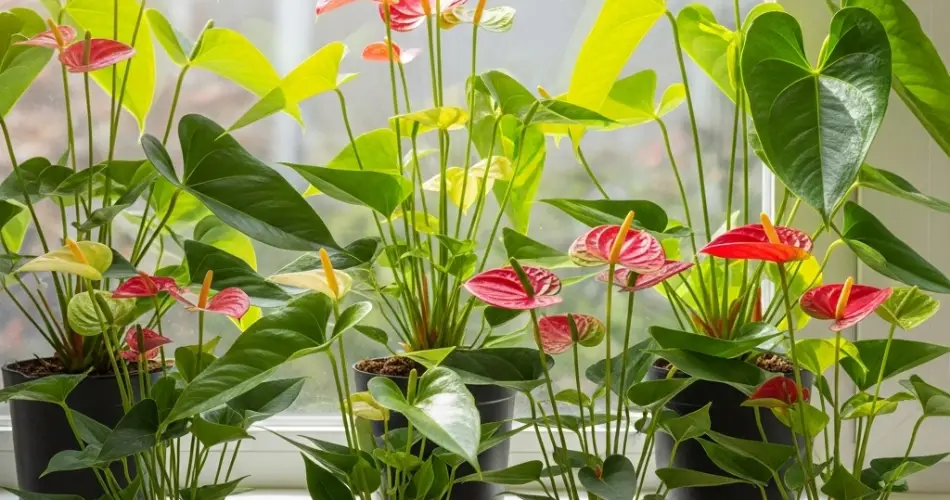Anthuriums are known for their striking, heart-shaped flowers and glossy foliage, making them one of the most eye-catching houseplants. While they are often associated with tropical greenhouses, anthuriums can be successfully grown in containers right at home—even on a sunny windowsill. With the right care and conditions, these vibrant plants can thrive indoors and bloom for months at a time.
Here’s a complete guide on how to grow anthurium in containers, especially in well-lit spaces like sunny windowsills.
Why Choose Anthurium?
Anthuriums are prized for their long-lasting, colorful spathes (often mistaken for flowers) and attractive dark green leaves. Native to tropical rainforests of Central and South America, they prefer warm, humid conditions but adapt surprisingly well to indoor environments.
With proper care, anthuriums can bloom multiple times a year, making them an excellent choice for brightening up living rooms, kitchens, or offices.
The Ideal Location: Sunny, but Filtered
Anthuriums love bright light but not direct sun. A sunny windowsill that receives filtered sunlight or morning sun is perfect. Too much direct sunlight can scorch the leaves and flowers, while too little light can prevent blooming.
If your windowsill gets harsh afternoon sun, consider using a sheer curtain to diffuse the light. East or north-facing windows are ideal. In winter months, when daylight is limited, a grow light can help supplement the natural light.
Choosing the Right Container
A well-draining container is essential for healthy anthuriums. Choose a pot with drainage holes to prevent water from pooling at the bottom, which can lead to root rot. Since anthuriums prefer snug conditions, a pot that’s just slightly larger than the root ball is ideal.
Terra cotta pots are a good option because they allow the soil to breathe, reducing the risk of overwatering. However, plastic or ceramic pots also work well as long as excess water can escape easily.
The Best Soil for Anthuriums
Anthuriums need a light, airy growing medium that retains some moisture but drains well. A good mix might include:
-
1 part orchid bark or coconut husk
-
1 part peat moss or coco coir
-
1 part perlite
This mix mimics the loose, well-drained soil found in their native habitat and supports healthy root development. Avoid heavy or compacted soils that hold too much moisture.
Watering the Right Way
One of the most common mistakes with anthuriums is overwatering. Allow the top inch of soil to dry out before watering again. Stick your finger into the soil—if it feels dry, it’s time to water. If it’s still damp, wait a few more days.
Water thoroughly until it runs out of the drainage holes, then empty the saucer beneath the pot. Anthuriums like consistent moisture but hate soggy roots.
During the growing season (spring and summer), water more frequently. In the cooler months (fall and winter), reduce watering to prevent excess moisture buildup.
Boosting Humidity
Since anthuriums are tropical plants, they appreciate higher humidity levels—ideally around 60%. If your home is dry, especially in winter, try one or more of the following:
-
Place a humidity tray (a shallow tray filled with water and pebbles) under the plant
-
Group plants together to create a more humid microclimate
-
Use a room humidifier
-
Mist the plant occasionally, avoiding direct misting on flowers
Fertilizing for More Blooms
Feed your anthurium every 6 to 8 weeks during the growing season with a balanced, water-soluble fertilizer diluted to half strength. Look for a fertilizer with equal parts nitrogen, phosphorus, and potassium (such as 20-20-20) or one slightly higher in phosphorus to encourage blooming.
Avoid over-fertilizing, as it can cause salt buildup in the soil and harm the roots. In winter, suspend feeding while the plant rests.
Regular Maintenance and Repotting
Remove dead or yellowing leaves to keep your anthurium looking its best. If your plant becomes root-bound or the potting mix breaks down, repot it in fresh soil. This is typically needed every 2 to 3 years.
Repot in spring using a slightly larger container and refresh the potting mix to ensure proper drainage and aeration.
Common Issues and Solutions
-
Brown leaf tips: Usually caused by low humidity or excess fertilizer.
-
Yellow leaves: Often a sign of overwatering.
-
No flowers: Could be due to low light or poor nutrition. Try adjusting light exposure and feeding schedule.
Final Thoughts
Growing anthuriums in containers on a sunny windowsill is both easy and rewarding. With proper light, well-draining soil, and regular but moderate watering, your anthurium can thrive indoors and brighten your space with vibrant, long-lasting blooms.
Whether you’re an experienced indoor gardener or a beginner, this tropical beauty adds a pop of color and elegance to any room.



